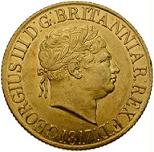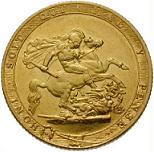In 1816, Great Britain enacted a coinage reform with momentous impact. The monetary politic of the first economic world power underwent a radical change and demonstrated to all other nations, how bimetallism could be given up in favor of pure gold standard. For after long years of shortage – first of silver, and then of gold – the British government recognized, that the stability of currency could only be guaranteed if rated after one single base metal. The rest of the currency became loan money and thus was underweighted.
bimetallism could be given up in favor of pure gold standard. For after long years of shortage – first of silver, and then of gold – the British government recognized, that the stability of currency could only be guaranteed if rated after one single base metal. The rest of the currency became loan money and thus was underweighted. The weigh of the new gold coin corresponded to one pound sterling. This gave the sovereign the form in which – on account of the leading role played by Britain in the world economy – it became the most important world coin up to World War I.
played by Britain in the world economy – it became the most important world coin up to World War I.
The new sovereign was minted in huge quantities. Its value equaled the earlier unit of account, the pound. The coin's device, a picture of St George slaying the dragon, is the work of the coin engraver Benedetto Pistrucci (*1784, †1855), who was highly respected at the court in London. The depiction of St George enjoys great popularity in England up to this day and appears on many recent gold coins as well as on the silver crowns.
 bimetallism could be given up in favor of pure gold standard. For after long years of shortage – first of silver, and then of gold – the British government recognized, that the stability of currency could only be guaranteed if rated after one single base metal. The rest of the currency became loan money and thus was underweighted.
bimetallism could be given up in favor of pure gold standard. For after long years of shortage – first of silver, and then of gold – the British government recognized, that the stability of currency could only be guaranteed if rated after one single base metal. The rest of the currency became loan money and thus was underweighted.  played by Britain in the world economy – it became the most important world coin up to World War I.
played by Britain in the world economy – it became the most important world coin up to World War I.
Tidak ada komentar:
Posting Komentar